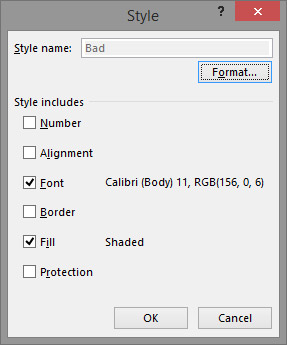Styles
Excel styles are a useful way to define certain features of cell content formatting and give them a name, so that we can later use them more easily to format similar tables. For example, a style with the title “Header” can be used to format the headers of all the tables we make. Once saved style can be applied multiple times, and the subsequent change of style automatically changes and the formatting characteristics of all the cells in which the style is applied.
Excel basically offers a large number of predefined styles. Existing styles can be found in the Home ribbon where, by clicking on the appropriate icon in the lower right corner of the palette of styles, we open the palette where the existing styles are displayed. If you right-click on the mouse, some of the styles will show a context menu that offers Apply, Modify, create an identical duplicate (Duplicate) or Delete. Also, this menu also offers an option to add to Quick Access Toolbar, which can be useful for the styles are common in use.

 If we choose the style modification option, a dialog window will appear in which the style name is displayed, and which formatting elements are used to create this style. Selection fields allow us to include or exclude individual formatting elements, and clicking the Format button opens the familiar dialog box Format Cells in which we can add, remove or modify certain formatting elements. The Duplicate option duplicates the existing style, or allows us to take all the elements of the formatting of a style, modify them and save them under a new name. The style palette, in addition to displaying existing styles, also offers options for creating new styles and joining styles that are displayed at the bottom of the palette. New Cell Style opens the same dialog box as when modifying the style, but this time it is expected that the style will be assigned a new name (the default name consists of the word Style and number) and adjust all the elements of its formatting. Each new style is based on the Normal style of formatting. When we have set all the formatting elements, by clicking the OK button in this dialog box we will create a new style. The Merge Styles option is used to take styles from another workbook. For example, it is possible to set some styles that will be used at the corporate level, and then use this option to download styles and apply them in an existing workbook.
If we choose the style modification option, a dialog window will appear in which the style name is displayed, and which formatting elements are used to create this style. Selection fields allow us to include or exclude individual formatting elements, and clicking the Format button opens the familiar dialog box Format Cells in which we can add, remove or modify certain formatting elements. The Duplicate option duplicates the existing style, or allows us to take all the elements of the formatting of a style, modify them and save them under a new name. The style palette, in addition to displaying existing styles, also offers options for creating new styles and joining styles that are displayed at the bottom of the palette. New Cell Style opens the same dialog box as when modifying the style, but this time it is expected that the style will be assigned a new name (the default name consists of the word Style and number) and adjust all the elements of its formatting. Each new style is based on the Normal style of formatting. When we have set all the formatting elements, by clicking the OK button in this dialog box we will create a new style. The Merge Styles option is used to take styles from another workbook. For example, it is possible to set some styles that will be used at the corporate level, and then use this option to download styles and apply them in an existing workbook.
How are styles applied? You need to select a cell or group of cells, then click on the name of the style in the palette, or click the name with the right mouse button, and apply the Apply option. By applying styles we will make the tables with which we work have a unified look, which makes them more orderly, more transparent, beautiful …
